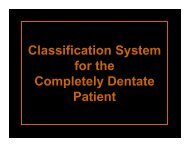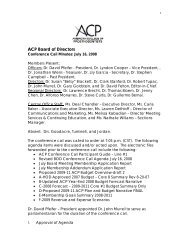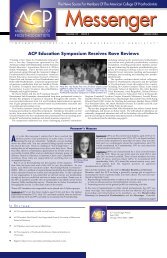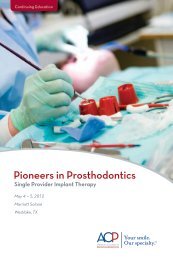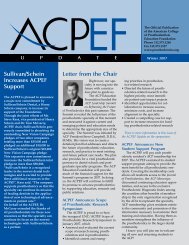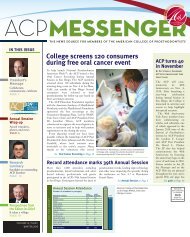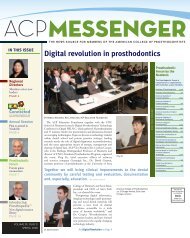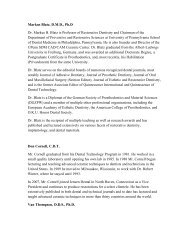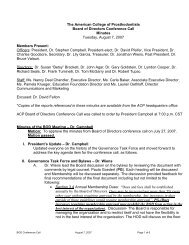PROSTHODONTICS - American College of Prosthodontists
PROSTHODONTICS - American College of Prosthodontists
PROSTHODONTICS - American College of Prosthodontists
Create successful ePaper yourself
Turn your PDF publications into a flip-book with our unique Google optimized e-Paper software.
TOPICS OF INTEREST Classification System for Partial EdentulismThomas j. McGarry) DDS/ Arthur Nimmo, DDS/James F. Skiba) DDS/Robert H Ahlstrom) DDS) MS) 4 Christopher R. Smith) DDS) 5Jack H Koumjian) DDS) MSD)6 and Nancy S. Arbree, DDS) MS7The <strong>American</strong> <strong>College</strong> <strong>of</strong> <strong>Prosthodontists</strong> (ACP) has developed a classification system for partialedentulism based on diagnostic findings. This classification system is similar to the classificationsystem for complete edentulism previously developed by the ACP. These guidelines are intended tohelp practitioners determine appropriate treatments for their patients. Four categories <strong>of</strong> partialedentulism are defined, Class I to Class IV, with Class I representing an uncomplicated clinicalsituation and class IV representing a complex clinical situation. Each class is differentiated byspecific diagnostic criteria. This system is designed for use by dental pr<strong>of</strong>essionals involved in thediagnosis and treatment <strong>of</strong> partially edentulous patients. Potential benefits <strong>of</strong> the system include (1)improved intraoperator consistency, (2) improved pr<strong>of</strong>essional communication, (3) insurance reimbursementcommensurate with complexity <strong>of</strong> care, (4) improved screening tool for dental schooladmission clinics, (5) standardized criteria for outcomes assessment and research, (6) enhanceddiagnostic consistency, and (7) simplified aid in the decision to refer a patient.] Prosthodont 2002;11:181·193. Copyright © 2002 by The <strong>American</strong> <strong>College</strong> <strong>of</strong> <strong>Prosthodontists</strong>.INDEX WORDS: diagnosis, treatment planning, prosthodontics, dental education, outcomesassessment, quality assurance, treatment outcomes, patient risk pr<strong>of</strong>ilesPARTIALLY EDENTULOUS patients exhibit a widerange <strong>of</strong> phys ical va riations and h ealth conditions. The a bse nce <strong>of</strong> organized diagnosticcriteri a for partia l ede ntulism has been a longstandi ng impedime nt to effective recogni tionJPrivate Practice, Oklahoma Cil)', OK.2Pr<strong>of</strong>e·Hor and Chainnan, Department o/Prosthodontics, Univmil)' 'IIFlorida <strong>College</strong>'ll Dtnh'''J', Cainsville, FL.>Private Practice, Ill/onldalr, JIIJ.1Private Practice, Reno, NV, aild Associate Clini"al Pr<strong>of</strong>essor, Department'II Restorative Denlifto" Univmity 'II the Pacific, Stockton, CA.5Associate Projessar, Department'll Clinical Su~ger)' , Universi t)' 'IIChica.~o, Chicago, IL."Clinical Associate Pr<strong>of</strong>essor, Deparlment 'II Restorative Dentisto"Universil)' 'if California-San Francisco School 'II Dentist')', SanFrancsico, CA, and Private Practice, Palo A lto, CA.?Pr,!/imor and As.wciate Dean 'llAcademic AIJairs, Tufts UnivmirySchool'll Den tal Medicine and Private Practice, Boston, j\1A .Accepled April 8, 2002.Thil" project wasfu II ded b)! the A me1ican Colle,~e '!/ ProstilOdonlisls.Presented at Ihe Annual Sessions'll Ihe <strong>American</strong> Dental EducationAssociation, Washin,glon, DC, April 2, 2000, and the Ameri"a" Coliegl! 'IIProsthodol1tists, Hawaii, November 15, 2000.Cormpondence to: Thomas]. McCarl)', DDS, 4320 McAulq Blvd.,Oklahoma Cil)', OK 73120.Copyright © 2002 by The <strong>American</strong> Coliege <strong>of</strong><strong>Prosthodontists</strong>1059-941X/02/1103-0006535 00/0doi. 10 1053/Jpro.2002. 126094<strong>of</strong> risk factors tha t may a ffect treatm e nt ou tcomes . Although described thoroughly in thedental li te rature,l.o the dive rse nat ure <strong>of</strong> pa rtia l ede ntulism has no t been organize d in sucha way to g uid e de nta l pr<strong>of</strong>ession als in the treatment planning process . T o address this problem,the <strong>American</strong> Coll ege <strong>of</strong> <strong>Prosthodontists</strong>(AC P) Subcommittee on Pros thodont ic Class ificat ion was form ed a nd ch arged with developinga class ific ation sys te m for partial ed entulismconsistent with the exis ting class ific a tionsys tem for complete edentulism. 2 A summary<strong>of</strong> the ACP edentul ous class ification sys te m 1Sgive n in T abl e I.T he purpose <strong>of</strong> this class ification system is toprovid e a framework for the organization <strong>of</strong> clinicalobservations. Clinical variables that establish different leve ls <strong>of</strong> partial edentulism are organized ina simplified, sequential progression designed to facilitateconsis te nt and predictabl e treatment planningdecisions. T his framework is designed to indicateincre asing levels <strong>of</strong> diagnostic and treatmentcompl exity presented by patients with varying degrees<strong>of</strong> partial ede ntuJism. This may suggestpoints at which referral to other specialists is appropriate.The framework is structured to supportJ ournal <strong>of</strong> Prosthodonlics, Vol I I, No 3 (Sep lember), 2002: jJfJ 181-193 1812010 CDEL Re-recognition <strong>of</strong> the Specialty Report 160 <strong>of</strong> 279



